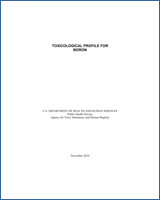NCBI Bookshelf. A service of the National Library of Medicine, National Institutes of Health.
Toxicological Profile for Boron. Atlanta (GA): Agency for Toxic Substances and Disease Registry (US); 2010 Nov.

Toxicological Profile for Boron.
Show details4.1. CHEMICAL IDENTITY
Boron appears in Group 13 (IIIA) of the periodic table and is the only nonmetal of this group (Jansen 2003). Table 4-1 lists common synonyms, trade names, and other pertinent information to identify boron and selected compounds.
4.2. PHYSICAL AND CHEMICAL PROPERTIES
Boron is a nonmetal and is typically found in nature bound to oxygen. It is never found as the free element (Cotton et al. 1999). Boron has two stable isotopes, 10B and 11B, which are naturally present at 19.10–20.31 and 79.69–80.90%, respectively (Jansen 2003). There are ten other known non-radioactive isotopes of boron (Lide 2008). Elemental boron exists in several allotropic forms (Jansen 2003). In addition to being an amphorous powder, boron has four crystalline forms: α-rhombohedral, β-rhombohedral, α-tetragonal, and β-tetragonal (Jansen 2003).
The chemical properties of boron are more similar to carbon and silicon than elements of its own group, although boron is more electron deficient. Boron has a high affinity for oxygen-forming borates, and reacts with water at temperatures above 100 °C to form boric acid and other boron compounds. The electron deficiency of boron does not allow conventional two-electron bonds, but rather multicenter bonds that are exclusively covalent (Jansen 2003; Schubert and Brotherton 2006). Boron hydrides consequently have structures quite different from hydrocarbons (Jansen 2003). The multi-center nature of boron allows the formation of a diverse array of covalent networks, rings, cages, and clusters. Boron forms strong covalent bonds with electronegative elements such as fluorine and oxygen (Schubert and Brotherton 2006).
Table 4-2 lists important physical and chemical properties of boron and selected compounds.
Table 4-1
Chemical Identity of Boron and Selected Boron Compounds.
Table 4-2
Physical and Chemical Properties of Boron and Selected Boron Compounds.
- CHEMICAL AND PHYSICAL INFORMATION - Toxicological Profile for BoronCHEMICAL AND PHYSICAL INFORMATION - Toxicological Profile for Boron
- Unit costs of health-care services - The epidemiology, management and impact of ...Unit costs of health-care services - The epidemiology, management and impact of surgical wounds healing by secondary intention: a research programme including the SWHSI feasibility RCT
Your browsing activity is empty.
Activity recording is turned off.
See more...